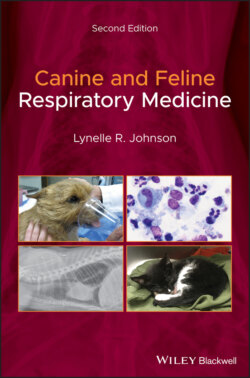Читать книгу Canine and Feline Respiratory Medicine - Lynelle Johnson R., Lynelle R. Johnson - Страница 34
Pulse Oximetry
ОглавлениеPulse oximetry provides an estimate of hemoglobin saturation with oxygen and is inexpensive, non‐invasive, and easy to perform. One problem with the technique is that it has low sensitivity and specificity in identifying normal versus abnormal arterial oxygenation in awake patients (Farrell et al. 2019). The technique relies on detection of the optical density of the pulse wave as blood passes through the arterial system. Therefore, measurement is impacted by pigment of the overlying tissue and potentially by the amount of light in the area. The sensor subtracts the signal between pulses from the height of the pulse wave to determine oxygenation of inflowing blood only. Because of this feature, pulse oximetry can provide a falsely low measurement in a hypotensive patient with weak pulses or in an animal with anemia. Patient movement can hamper detection of the impulse. Finally, this technique cannot differentiate between methemoglobin and oxyhemoglobin and will be inaccurate in any animal with a dyshemoglobinemia.
Pulse oximetry is useful prior to anesthetizing the patient for a respiratory procedure, as it provides a baseline for comparison during recovery. Sites that can be used to obtain a measurement include the lip, tongue, between the toes, on the ear pinna, on the vulva or penis, and sometimes on the flank fold. The probe can be applied to various sites several times to obtain a signal, and detection of a strong pulse rate suggests that the reading is likely accurate. A pulse oximeter reading below 95% correlates with a partial pressure of oxygen (PaO2) of less than 80 mmHg (Figure 2.2). When such a reading is obtained, an arterial blood gas analysis should be performed, if available, to confirm the presence and degree of hypoxemia. It is important to remember that the pulse oximeter measures only oxygenation. Hypoxemia is absent in up to 7% of dogs with abnormal pulse oximetry readings and can be present in a similar proportion of dogs with pulse oximetry readings above 95% (Farrell et al. 2019). Therefore, an arterial blood gas would be advised whenever possible to ensure an accurate assessment of the patient, although in a practice setting this is rarely possible. Importantly, pulse oximetry provides no information on ventilatory status and thus cannot detect hypoventilation – increased partial pressure of carbon dioxide (PaCO2) – in an animal; however, a venous blood gas analysis can be used as an approximation.
Pulse oximetry can be valuable in determining response to therapy in hypoxemic patients, because improvements in oxygenation occur prior to radiographic changes. However, because of the sigmoidal relationship between hemoglobin saturation and arterial oxygen, oximetry remains a somewhat crude estimate of lung function. Also, this curve is shifted to the right (reducing the affinity of hemoglobin for oxygen and enhancing tissue delivery) by conditions associated with exercise and disease, such as increased temperature, decreased blood pH, increased PaCO2, and increased 2,3‐diphosphoglycerate (DPG) produced in red blood cells during glycolysis. Thus, changes in disease status can hamper the interpretation of results. Other clinical features can impact interpretation of the oxyhemoglobin saturation curve. Stored red blood cells have lower concentrations of 2,3‐DPG, and transfusion with this product increases the affinity of hemoglobin for oxygen and reduces oxygen delivery to the tissues. It appears that this is primarily a concern during the first 4–12 hours after transfusion, until 2,3‐DPG concentrations rebound. Finally, hypophosphatemia also decreases 2,3‐DPG.
Figure 2.2 Pulse oximetry measures hemoglobin saturation with oxygen, which has a sigmoidal relationship with the partial pressure of arterial oxygen (PaO2). A hemoglobin saturation <95% equates to a PaO2<80 mmHg and indicates hypoxemia.
